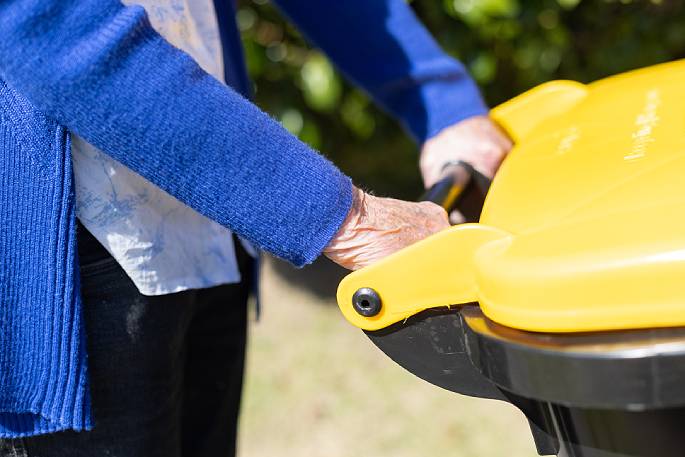To lid or not to lid? That is the question.
It’s one of those niggly debates that pops up at dinner parties — do you take the lids off bottles or leave them on when you are recycling?
Until recently the answer has been, it all depends on where you live. But, with the introduction of standardised kerbside recycling rules across New Zealand on February 1, it is now the same for everyone.
The good news is, here in the Western Bay, very little has changed because we’re ahead of the game and already meeting most of the new requirements.
And, yes, that includes lid etiquette. If you didn’t already know, lids should be removed from all bottles, jars and containers and placed in the red lid rubbish bin. The clean containers then go into your recycling — which many of you are already doing. Ka pai!
So, what is changing?
Aerosol cans must now go in your red lid rubbish bin, as most recycling plants in New Zealand don’t have the equipment needed to compact them safely.
Aluminum and tin foil trays also go in the red lid rubbish bin, as their size, shape and weight mean they are often unable to be sorted by machinery.
Another change in the Western Bay is how you line your food scraps bin. Plain brown paper bags are preferred, as the inks in newspapers and other printed materials often contain heavy metals and/or microplastics and we want to keep these out of the food chain.
Standardising what does (and doesn’t) go into kerbside recycling bins across the country makes it easier for people to do the right thing and will result in less recyclable items ending up in landfill due to contamination.
As a popular holiday destination, particularly over summer, the Western Bay attracts a lot of visitors who will be able to bring their recycling habits with them, without having to upskill on local variations.
In the past financial year, we collected 1808 tonnes of mixed recycling and 456 tonnes of food scraps, with 42 percent of all kerbside waste in the District diverted from landfill.
In December 2023, an impressive 84 per cent of recyclable items collected at the kerbside were able to be recycled. The remaining 16 percent went to landfill because the items were contaminated or not recyclable. The average monthly contamination last year was 19.7 per cent.
Together, we can do even better by making sure bottles and containers are empty and clean, and the right things go into the right bins.
In a nutshell, here’s what can be recycled at the kerb:
- Glass bottles and jars (except very small)
- Paper and cardboard
- Plastic bottles, trays and containers - numbers 1, 2 and 5 only
- Aluminium and steel tins and cans
A good rule of thumb is, if it’s from your kitchen (food and beverage), bathroom or laundry, it’s more than likely recyclable.
Of course, the best way to lessen both your recycling and rubbish is to apply the other three ‘Rs’ wherever possible — refuse, reduce and reuse.
But, if you’re looking for your next dinner party debate, here are some other things that can catch people out:
Undersized items
Items should be larger than 50mm x 50mm; any smaller and they can’t be sorted effectively, for example lids and small medicine bottles. However, some smaller items can be recycled through product take-back schemes or community resource recovery centres, like Envirohub’s Precious Plastic scheme, which recycles plastic lids.
Oversized items
Plastic, metal and glass containers larger than 4L don’t go in your kerbside recycling bin because they are too big to be processed on automated sorting lines. Whiteware and bulky metal objects can be taken to the Te Puke Recycling Centre, or a scrap metal yard. Other homewares that are still in a usable condition may be accepted by second-hand shops.
Plant pots
Many plant pots are black or dark plastics, which are difficult for optical technology to sort correctly. They can also be dirty and contaminate other recycling. The good news is many garden stores, including Mitre 10 and Bunnings, operate drop-off for these in store.
Liquid paperboard (LPB) cartons
Liquid paperboard (LPB) cartons, for example Tetra Pak, cannot be recycled in your yellow lid kerbside bin. There are currently no special collection points for this product in the WBOPDC area. Discard these containers in the red lid rubbish bin. Alternatively, try to purchase milk and juice in containers that can be recycled at the kerbside.
Still not sure what’s recyclable and what’s not? Try our handy recycling search tool.



4 comments
WRONG
Posted on 27-01-2024 11:58 | By Yadick
A lot of plant pots have recycling symbol #5 on them. Happy recycling.
The Master
Posted on 27-01-2024 12:26 | By Ian Stevenson
So that means that the half sized red bin (compared to the 2x yellow bin need to be swapped around a bit. As more goes to the tip, the red bin needs to be bigger obviously.
Why..
Posted on 27-01-2024 14:24 | By fair game
is it so hard to read the recycling numbers underneath plastic bottles? They should be in black, or a contrast colour to the bottle. I just give up and throw them all in the recycling because of this.
south city
Posted on 27-01-2024 18:28 | By Kancho
I used to go to Maleme street transfer station and was recycling a lot where I could and green waste . Since the council took away the service I find it all to difficult so a lot more goes into the red bin even though I know it is highly recyclable or excess green waste in the red bin also. I don't have a trailer so would take two loads to Maleme street but certainly not going to travel 20 plus round trip to the transfer station . Its no surprise to also see people dumping allsorts on the side of the road when travelling all the way across the city to the ony transfer station to be then charged to use the facility . So a poor service indeed especially for the south city
Leave a Comment
You must be logged in to make a comment.